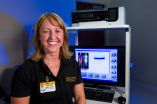(Press-News.org) Boston, MA-- A marker commonly used to determine if a patient is having a heart attack can also be used to identify stable patients at high risk for deadly cardiac events, according to a new study led by investigators at Brigham and Women's Hospital (BWH). Using a test that is more sensitive than what is currently used in U.S. hospitals and clinics, the research team found that nearly 40 percent of patients with type 2 diabetes and stable heart disease had abnormal blood levels of the protein troponin. Patients with elevated levels of troponin were twice as likely as their counterparts to die from heart attack, stroke or other cardiovascular causes within five years. The team also found that a key therapeutic intervention known as coronary revascularization, frequently used in patients with heart attack and an abnormal troponin, did not lower stable patients' elevated troponin levels or their risk of deadly cardiac events. The findings are published in the August 13, 2015 issue of The New England Journal of Medicine.
"The patients in our study were not having symptoms of a heart attack, and yet a remarkably high proportion of them had an abnormal troponin, suggesting they were experiencing ongoing injury to their hearts," said lead author Brendan Everett, MD, MPH, of BWH's Divisions of Cardiovascular Medicine and Preventive Medicine. "This test was able to identify patients at increased risk of heart attack, heart failure, or death, even after we accounted for other patient characteristics and risk factors. In the future, if we can understand what causes the abnormal troponin, we may be able to identify new strategies to treat this group of high-risk patients. One strategy we tested in this study - opening the coronary arteries of stable patients with abnormal troponin - did not reduce the risk of future heart attack or death."
Everett and colleagues measured troponin concentrations from more than 2,200 patients who had both type 2 diabetes and stable heart disease using a highly sensitive test (a high-sensitivity electrochemiluminescence assay) that is currently in use in Europe, and is being studied for use in the U.S. After five years, 27 percent of the patients with abnormal troponin levels went on to die of a heart attack, stroke, or cardiovascular causes, compared to 13 percent of patients with normal troponin levels.
Half of the patients involved in the trial received prompt coronary revascularization - a procedure to open the coronary arteries using either stents or coronary bypass graft surgery. However, the procedure did not appear to reduce the risk of cardiovascular-related death in these stable patients with elevated troponin, nor did it reduce troponin levels.
"We know that circulating troponin concentrations reflect ongoing injury to the heart's muscle tissue, but the causes of this ongoing injury are not completely clear. In the right clinical situation, we would typically interpret the abnormal troponin levels as indicative of an ongoing heart attack, which we often treat by finding the blocked artery and opening it; however, our results indicate that such procedures do not reduce the risk of future heart attack or death in these patients," said Everett. "We need alternative strategies to improve outcomes in this group of high-risk patients."
Researchers note that further studies to understand what causes abnormal troponin and why patients with abnormal troponin are at greater risk for cardiovascular-related death may lead to alternative treatment options and interventions for patients.
INFORMATION:
Other researchers who contributed to this work include Maria Mori Brooks, Helen E.A. Vlachos, Bernard R. Chaitman, Robert L. Frye and Deepak L. Bhatt for the BARI 2D Study Group.
This work was supported by grants (U01HL061744, U01HL061746, U01HL061748, U01HL063804, and R21HL121495) from the National Heart, Lung, and Blood Institute and the National Institute of Diabetes and Digestive and Kidney Diseases of the National Institutes of Health and by an investigator-initiated research grant from Roche Diagnostics. Everett reports receiving grant support from Roche and Novartis and fees for serving on a clinical events committee from Genzyme. Brooks reports receiving grant support from Gilead Sciences.
Chaitman reports receiving fees for serving on clinical events committees from Merck, Eli Lilly, and Novo Nordisk, and fees for serving on data safety monitoring boards from Pfizer and Sanofi-Aventis. Bhatt reports serving on advisory boards for Cardax, Medscape Cardiology, and Regado Biosciences, receiving fees for serving on a steering committee from WebMD, receiving research funding through his institution from Amarin, AstraZeneca, Bristol-Myers Squibb, Eisai, Ethicon, Forest Laboratories, Ischemix, Medtronic, Pfizer, Roche, Sanofi-Aventis, and The Medicines Company; participating in unfunded research collaborations with FlowCo, PLx Pharma, and Takeda; and serving as an investigator in studies funded by Biotronik and St. Jude Medical though his institution.
Brigham and Women's Hospital (BWH) is a 793-bed nonprofit teaching affiliate of Harvard Medical School and a founding member of Partners HealthCare. BWH has more than 4.2 million annual patient visits, nearly 46,000 inpatient stays and employs nearly 16,000 people. The Brigham's medical preeminence dates back to 1832, and today that rich history in clinical care is coupled with its national leadership in patient care, quality improvement and patient safety initiatives, and its dedication to research, innovation, community engagement and educating and training the next generation of health care professionals. Through investigation and discovery conducted at its Brigham Research Institute (BRI), BWH is an international leader in basic, clinical and translational research on human diseases, more than 1,000 physician-investigators and renowned biomedical scientists and faculty supported by nearly $600 million in funding. For the last 25 years, BWH ranked second in research funding from the National Institutes of Health (NIH) among independent hospitals. BWH continually pushes the boundaries of medicine, including building on its legacy in transplantation by performing a partial face transplant in 2009 and the nation's first full face transplant in 2011. BWH is also home to major landmark epidemiologic population studies, including the Nurses' and Physicians' Health Studies and the Women's Health Initiative as well as the TIMI Study Group, one of the premier cardiovascular clinical trials groups. For more information, resources and to follow us on social media, please visit BWH's online newsroom.
When it comes to reproduction, not every individual equally pulls his or her weight. Dana Herman and Mark Colwell of Humboldt State University spent 13 years tracking the successes and failures of almost 200 individual Snowy Plovers (Charadrius nivosus) nesting at a variety of sites in Humboldt County, California, to identify the factors that could be influencing reproductive success for birds in this threatened population. Their results, published this week in The Condor: Ornithological Applications, show that more than human activity, predator presence, exclosures to ...
Working in groups is advantageous because different individuals can be responsible for different information, allowing each individual to develop more in-depth expertise. For instance, a plumber, electrician, and carpenter work together to build a house, but each is responsible for unique aspects of the project. This is an example of a transactive memory system: information is distributed across the group, and each group member is aware of what he or she knows, as well as who knows what.
Because the Internet surpasses any person in accessibility, speed, and breadth of ...
COLUMBIA, Mo. (Aug. 12, 2015) Approximately 60 percent of young people habitually skip breakfast up to four times a week, previous research has shown. Although health experts recommend breakfast as a strategy to reduce an individual's chance of obesity, little research has examined if the actual type of breakfast consumed plays a significant role in one's health and weight management. University of Missouri researchers compared the benefits of consuming a normal-protein breakfast to a high-protein breakfast and found the high-protein breakfast - which contained 35 grams ...
All freshwater streams and rivers actually release carbon dioxide, but the source of those emissions has for years been unclear to scientists.
Now, researchers have shown that the greenhouse gas appears in streams by way of two different sources -- either as a direct pipeline for groundwater and carbon-rich soils, or from aquatic organisms releasing the gas through respiration and natural decay.
CO2's origins -- land or life -- depend largely on the size of the stream or river, according to a paper published Aug. 10 in Nature Geosciences. These findings shed light ...
For any computer, being able to manipulate information is essential, but for quantum computing, singling out one data location without influencing any of the surrounding locations is difficult. Now, a team of Penn State physicists has a method for addressing individual neutral atoms without changing surrounding atoms.
"There are a set of things that we have to have to do quantum computing," said David S. Weiss, professor of physics. "We are trying to step down that list and meet the various criteria. Addressability is one step."
Quantum computers are constructed and ...
Simply put, cancer is caused by mutations to genes within a cell that lead to abnormal cell growth. Finding out what causes that genetic mutation has been the holy grail of medical science for decades. Researchers at the Texas A&M Health Science Center Institute of Biosciences and Technology believe they may have found one of the reasons why these genes mutate and it all has to do with how stem cells talk to each other.
The landmark studies by Texas A&M researchers Fen Wang, Ph.D., and Wallace McKeehan, Ph.D., appear in the Journal of Biological Chemistry and are available ...
CAMBRIDGE, MA -- Chemists working in a variety of industries and fields typically go through a laborious process to measure and mix reagents for each reaction they perform. And many of the common reagents they use sit for months or years on shelves in laboratories, where they can react with oxygen and water in the atmosphere, rendering them useless.
In a paper published this week in Nature, researchers at MIT describe a technique that could help avoid this costly waste, and greatly reduce the number of steps a chemist must perform to prepare common compounds for use in ...
Male elephant seals compete fiercely for access to females during the breeding season, and their violent, bloody fights take a toll on both winners and losers. These battles are relatively rare, however, and a new study shows that the males avoid costly fights by learning the distinctive vocal calls of their rivals. When they recognize the call of another male, they know whether to attack or flee depending on the challenger's status in the dominance hierarchy.
Researchers from UC Santa Cruz have been studying the behavior of northern elephant seals at Año Nuevo ...
BOSTON - Researchers from Beth Israel Deaconess Medical Center (BIDMC) are homing in on the potential benefits of allowing patients access to the notes their clinicians write after a visit. An article published in the August edition of The Joint Commission Journal on Quality and Patient Safety suggests that this kind of patient engagement has the power to improve safety and quality of care.
The practice of sharing visit notes more readily began with the OpenNotes study in 2010. More than 100 primary care doctors at three hospitals invited 20,000 of their patients to ...
In debt and don't know what to do? Conventional economic wisdom says to pay off high-interest loans first. Yet according to a new study in the Journal of Marketing Research, paying off your smallest debts first can provide the motivation you need to successfully pay off even the most burdensome debts.
"Winning what are known as 'small victories' by paying off small debts first can give consumers a real boost in eventually paying off all their debts," write the authors of the study, Alexander L. Brown (Texas A&M University) and Joanna N. Lahey (Texas A&M University). "The ...



